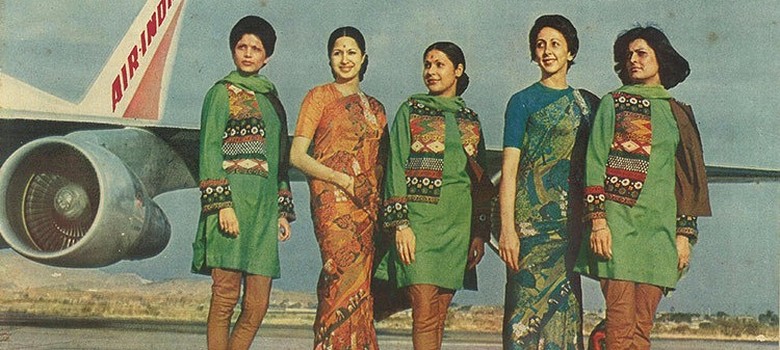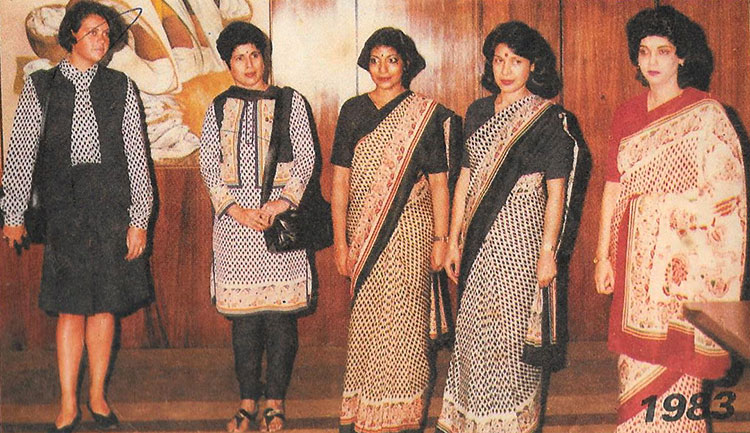
Some people called them “glorified ayahs”, while they were patronisingly referred to in Hindi as hawayi sundaris. Yet, in the 1970s and ’80s, Indian air hostesses were also envied as glamourous, elite women who looked like film stars, jet-setted across the world and enjoyed exotic holidays that few others could afford.
In September 1986, when 23-year-old Neerja Bhanot died trying to save passengers of the ill-fated Pan Am Flight 73 from the bullets of hijackers, Indians saw – perhaps for the first time – that an air hostess could also be a hero.
The Mumbai-New York Pan Am flight was hijacked during a lay-over in Karachi by Palestinian militants from the Abu Nidal Organisation. In the 17 hours that followed, Bhanot took charge as the head purser, saving scores of lives by hiding the passports of American citizens, helping passengers escape through an emergency exit and, eventually, shielding three children from a rain of bullets. After her death, she became the youngest Indian to be awarded the Ashok Chakra for bravery.

Now, 30 years later, filmmaker Ram Madhvani is reviving Bhanot’s story for a new generation with his biopic Neerja. The film, starring Sonam Kapoor as Bhanot, will be released on February 19. “Whether in 1986 or today, a whole bunch of flight attendants do their duty so that we can do ours – and we rarely show gratitude for that,” Madhvani said. “In some ways, the film is a tribute to them.”
But being an air hostess in the ’80s was, in many ways, vastly different from being a flight attendant today. It was an era of fewer airlines, more luxury and greater glamour. Despite the alarming number of aircraft attacks and hijackings taking place through the ’70s and ’80s, it was an age far less obsessed with security than the post-9/11 world.
‘We had to know our wine and cheese’
“When I started out, we were trained to focus on service, not safety and security,” said Elfin Fernand, a Mumbai resident who joined Air India as a hostess in 1974 at the age of 21 and retired in 2009. “We had to know our wines and cheese and how to look after the passenger’s comfort. Today’s flight attendants have to be constantly alert, so even while talking to a passenger their eyes dart all over the place.”
Fernand’s career took off at a time when the perception of air hostesses had rapidly begun to change in India. Earlier, the women almost always came from Anglo-Indian, Catholic or Parsi families. In the rest of Indian society, flying, serving passengers and working with men was not looked upon as a respectable profession for a young woman.
“Many of the Hindu girls who came for air hostess interviews in the ’60s and early ’70s either had to fight with their parents or lie to them,” said Mahrukh Chikliwala, a veteran Air India flight attendant who flew from 1969 to 2009 and retired as a trainer for younger staff. “But many people also envied our work, because it didn’t need a lot of educational qualifications but paid very well.”

By the time women like Neerja Bhanot – who came from an educated Punjabi family in Mumbai – joined the field, young girls across India were dreaming of a life as an air hostess. One of them was Suneeta Sodhi-Kanga, who wanted to be an air hostess since she was six and was actively encouraged by her family.
“I was always fascinated with the glamour of flying – the elegance and charm of the well-groomed hostesses, their confidence and the prospect of travelling the world,” said Kanga, who worked with Air India from 1988 to 1996 and now trains corporate professionals in grooming, etiquette, fine dining and wine appreciation. In 1989, after Kanga won the Miss World Airline pageant held in Paris, she became the face of Air India at various cultural and publicity events.

No weight gain, no acne, no glasses
The attention that air hostesses received for their grooming and beauty, however, came with a heavy dose of gender discrimination. Male flight attendants were hardly ever spoken about, but air hostesses were objects of fascination, and their looks a subject of much discussion.
In 1971, the Illustrated Weekly of India did a cover story on air hostesses that featured a telling classification of the women employed with the three main airlines operating in the country:
“BOAC [British Overseas Airways Corporation] lays stress on the healthy, nurse-like mantronly look…Air-India goes in for youth and glamour and patronises both the campus and the harem look. Indian Airlines goes in for the ‘desi’ demeanour – in the India-can-do-it fervour…Glamour with a campus touch and a come-hither look is a general characteristic of the Air-India hostess.”

“We women could be taken off cabin duty if we put on weight, wore glasses or developed acne, but this did not apply to male attendants,” Chikliwala said. “The men had no restrictions on marriage, but when I joined, air hostesses were not allowed to marry. Even divorcees were a problem.”
In 1979, after taking their case to court, Air India’s women cabin crew won the right to marry without losing their jobs or being grounded to do off-flight duties. They had to fight further to be allowed at least two children, but many other battles had to continue.
As an employee of Pan Am, an American airline, Bhanot was able to climb from the post of a cabin attendant to a head purser – the senior-most cabin manager – within just a year of flying. Had she been working for an Indian airline, Bhanot would never have been even a junior purser, simply because she was a woman.
At Air India, right up to the mid-2000s, only male flight attendants were allowed to take on positions requiring management and supervision in an aircraft. “The men were called pursers and the women were hostesses,” said Francis Monteiro, a retired Air India flight attendant from Mumbai who flew with the airline from 1977 to 2011. “The senior pursers could work in the galley and supervise, but hostesses worked only in the cabin. They were the face of the airline.”
Most air hostesses, says Monteiro, joined the field by the time they were 18. Most men joined at the age of 21. “Often, this meant that men would be supervising women their own age even though the women were more experienced,” he said.
This, too, was a battle that Air India’s hostesses had to fight in court, and victory came rather late in the day. “In 2006, I became the first woman to be made a flight in-charge, three years before I retired,” said Mahrukh Chikliwala.
Along with Elfin Fernand, Chikliwala was among the women who also fought for parity with male cabin crew in the case of retirement age. While men could retire at 58, women had to retire at 35 in the 1970s and ’80s – a figure that Air India raised to 45 in 1990 and 50 in 1993. By the time the women’s retirement age was raised to 58, it was already 2003, 14 years after Indian Airlines, the government’s domestic carrier, implemented the same decision.
Dangerous times?
While battling gender disparities in a field that inherently sexualises women, flight attendants of the time also had to grapple with the dangers of flying. The ‘70s and ‘80s saw a peak in aircraft explosions and hijackings, particularly because of the political instability in the Middle East and Cuba. Closer to home, Sikh militants from the Khalistan movement made at least four attempts to attack or hijack flights during those two decades.
In 1985, a year before Bhanot was killed by Palestinian hijackers, a Sikh militant group bombed Air India’s Emperor Kanishka flight en route from Canada to London. The plane exploded over the Atlantic Ocean at 31,000 feet, killing all 329 people on board.
“That was incredibly scary because it could easily have been me on that flight,” said Francis Monteiro, who had been on the staff of the same flight during its Frankfurt-Toronto leg a week before the attack. “I lost several colleagues and two batch-mates in that explosion.”
Rude, romantic
Keeping calm during emergency situations, however, is something almost all flight attendants imbibe during their training and years of experience. Often, cabin crew members found it harder to remain calm while dealing with insolent passengers – something that has not changed much in all these years.
“Indian passengers are particularly rude – many of them treat flight attendants like their domestic servants,” said Tehmi Ghadialy, who served as an Indian Airlines hostess from 1968 to 1988 and now works as a Japanese interpreter and tourist guide in Mumbai. “I’ve told off some Bollywood celebrities and ministers for being rude to the cabin crew.”
Despite the flipside, though, retired flight attendants are clear that they loved their jobs more than anything else, because the field had so much excitement to offer. Flight frequencies were lower in the ‘80s, so after a long international flight, crew members got up to a week’s break in different parts of the world, with five-star accommodation and opportunities to travel for free.

“It was quite a fashionable life. I had my favourite places to shop everywhere, from Cairo to Mauritius to Beirut,” said Elfin Fernand. A huge rock music fan, Fernand often requested for specific flights based on the schedules of major rock concerts. “I’ve seen every major band perform live around the world, including Led Zeppelin.”

Of course, for flight attendants, romance was also often “in the air”. Francis Monteiro fell in love with his wife, an air hostess and junior colleague, while at work in the ‘80s, and the couple now have two grown daughters. More famously, Parmeshwar Godrej and Maureen Wadia – wives of business tycoons Adi Godrej and Nusli Wadia respectively – were once Air India hostesses who are said to have met their spouses while hosting them on flights.
“Oh, there are many cases of air hostesses marrying first-class passengers,” said Monteiro. Such hitching, however, was not really a two-way street. “Which first-class woman passenger would pay attention to male pursers?”
[“source-scroll”]





